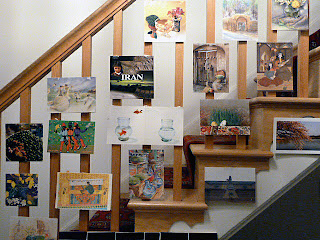 |
Touri Mehran prepares for a Persian New Year (also known as Nowruz)
party at her house in Bethesda, Md. on Mar. 20, 2013, to celebrate the beginning
of spring.
|
 |
One of the most common components of the Persian New Year is
a Haft Sin (also known as the traditional table setting of Nowruz).
|
 |
One part of the Haft Sin possesses decorated eggs, which
symbolize humans and fertility.
|
 |
Here are just a few of the postcards the Mehran’s have
received for Persian New Years.
|
 |
From left to right, Christina Mehran and Daniel Ashtary-Yazdi,
as well as Bahador Moinian and Afsi Goodarzpoor, are seen chatting before dinner.
|
 |
Dinner is about to be served as all of the food has been cooked
and is ready to go on the table.
|
 |
In this image, the two bowls of rosewater symbolize water,
which is believed to have magical cleansing powers, while the wheat sprouts
represent rebirth.
|
 |
From left to right, Mazi Moinian, Nader Mehran, Daniel
Ashtary-Yazdi, Ally Drysdale, Sara Moinian, and Niloofar Ashtary-Yazdi, are
seen eating dinner.
|
 |
Bahador Moinian (left), and Daniel Ashtary-Yazdi (right),
are seen viewing an image on a smartphone after dinner.
|
 |
After dinner, Kourosh Ashtary-Yazdi takes a peak at the
decorated eggs in the Haft Sin.
|
 |
Christina Mehran (left), and Zia Mehran (middle), are seen
dancing just before dessert, as Bahram Nozad (right) looks on.
|

1 comment:
air jordans
ralph lauren uk
michael kors handbags
yeezy shoes
jordan shoes
coach outlet online
coach factory outlet
christian louboutin outlet
stephen curry shoes
nike shoes
Post a Comment